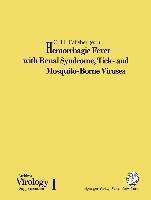Hemorrhagic Fever with Renal Syndrome, Tick- and Mosquito-Borne Viruses
BücherAngebote / Angebote:
Editor¿s comments.- Geographical distribution of hemorrhagic fever with renal syndrome and hantaviruses.- Diagnostic potential of a baculovirus-expressed nucleocapsid protein for hantaviruses.- Rapid serodiagnosis of hantavirus infections using high density particle agglutination.- Field trial of an inactivated vaccine against hemorrhagic fever with renal syndrome in humans.- Reservoirs and modes of spread of hemorrhagic fever with renal syndrome, a zoonotic nontransmissible human disease.- Pathogenesis of hemorrhagic fever with renal syndrome virus infection and mode of horizontal transmission of hantavirus in bank voles.- Hemorrhagic fever with renal syndrome in Bulgaria: isolation of hantaviruses and epidemiologic considerations.- Association of chronic renal disease, hypertension, and infection with a rat-borne hantavirus.- Prevalence of antibody to hantaviruses in humans and rodents in Italy. Provisional evidence of Hantaanlike virus infections in humans and Seoul-like virus infections in rodents.- Evidence of the presence of two hantaviruses in Slovenia, Yugoslavia.- Panhypopituitarism in the acute stage of hemorrhagic fever with renal syndrome: a case report.- Stabilized Ribavirin diphosphate analogs inhibit the vesicular stomatitis virus (Indiana) in vitro transcription reaction.- Early events in infection with arenaviruses.- A study of the NS3 nonstructural protein of tick-borne encephalitis virus using monoclonal antibodies against the virus.- The envelope protein E of tick-borne encephalitis virus and other flaviviruses: structure, functions and evolutionary relationships.- Antigenicity of flaviviruses.- Laboratory diagnosis of tick-borne encephalitis.- New perspective vaccines from tick-borne encephalitis virus propagated in green monkey kidney cell cultures.- Characterization of Dugbe virus by biochemical and immunochemical procedures using monoclonal antibodies.- Studies of the pathogenesis of Dugbe virus in normal and in immunosuppressed mice.- Dugbe virus susceptibility to neutralization by monoclonal antibodies as a marker of virulence in mice.- Dugbe virus in ticks: histological localization studies using light and electron microscopy.- Biological and molecular characteristics of orbiviruses and orthomyxoviruses isolated from ticks.- Characterization of tick salivary gland factor(s) that enhance Thogoto virus transmission.- Serological evidence of the distribution of California serogroup viruses in the U.S.S.R..- Signs and symptoms of infections caused by California serogroup viruses in humans in the U.S.S.R..- Arbovirus activity in Canada.- Surveillance for arboviruses in the Soviet Union: relationships between ecologic zones and virus distribution.- Natural foci of arboviruses in far northern latitudes of Eurasia.- Seroepidemiological survey for antibodies to arboviruses in Greece.- Sandfly fever in Central Asia and Afghanistan.- Isolation of Crimean-Congo hemorrhagic fever virus from patients and from autopsy specimens.- Ecology of ticks as potential vectors of Crimean-Congo hemorrhagic fever virus in Senegal: epidemiological implications.- Epidemiology of Crimean-Congo hemorrhagic fever in Senegal: temporal and spatial patterns.- Abstracts.- Detection and differentiation of tick-borne encephalitis virus strains by nucleic acid hybridization.- Structure and organization of tick-borne encephalitis virus genome.- Detection by time-resolved fluoroimmunoassay of antibodies in patients with tick-borne encephalitis.- Monoclonal antibodies used to study antigenic characteristics of Powassan virus strains isolated in the Primorye Territory, eastern U.S.S.R.- Syrdaria Valley fever, a new virus disease in Kazakhstan.- Isolation of a Getah-like virus (family Togaviridae, genus Alphavirus, Semliki Forest antigenic complex) from mosquitoes collected in Mongolia.- Immune blotting studies of California encephalitis antigenic complex viruses recently isolated in the U.S.S.R..
Folgt in ca. 5 Arbeitstagen


